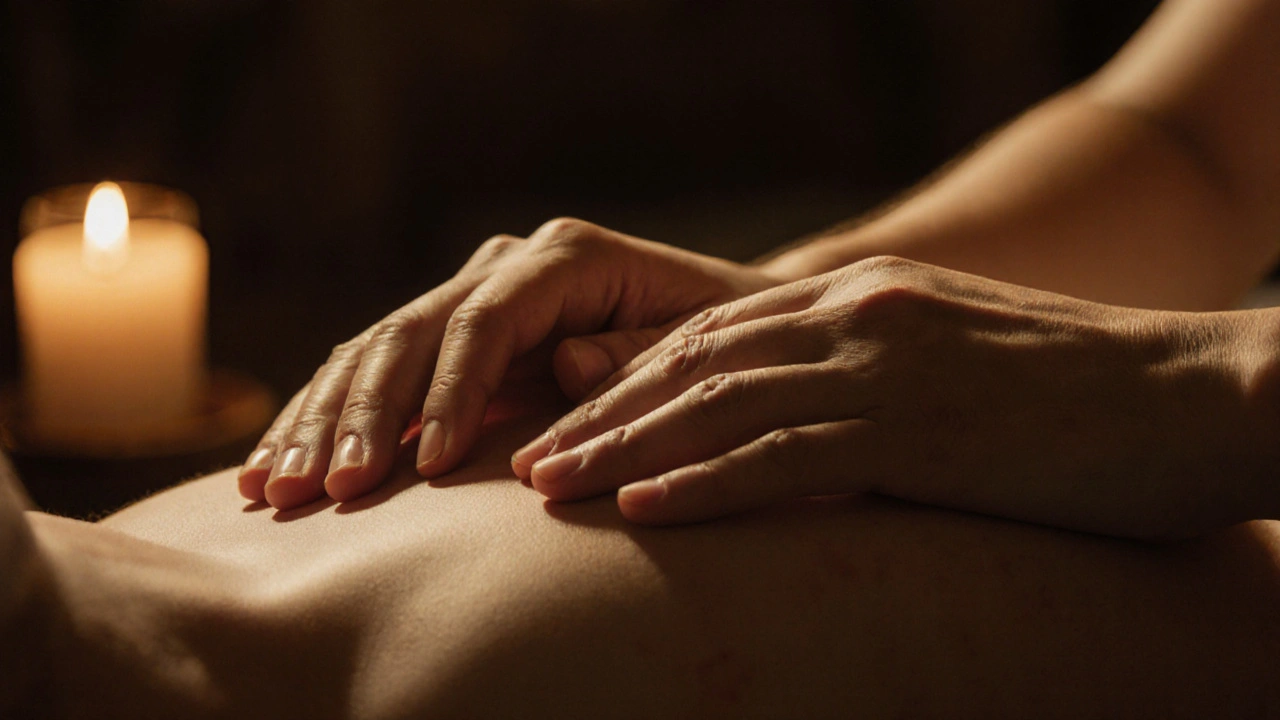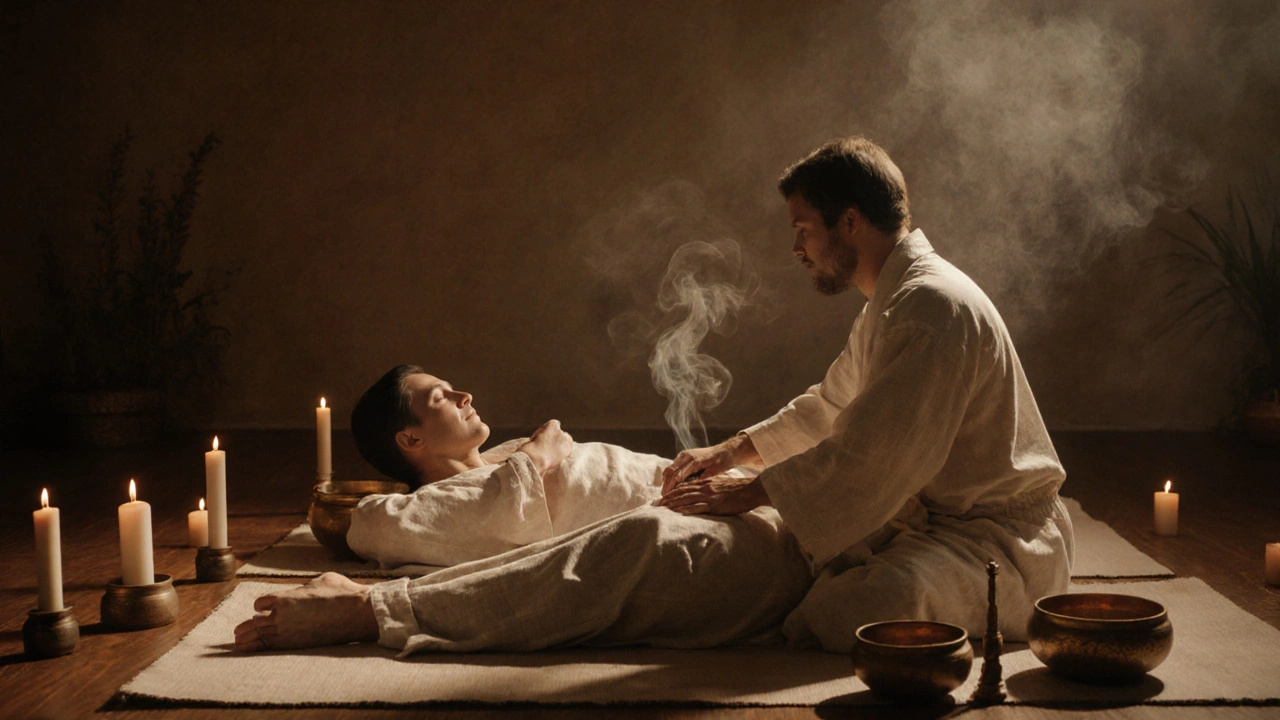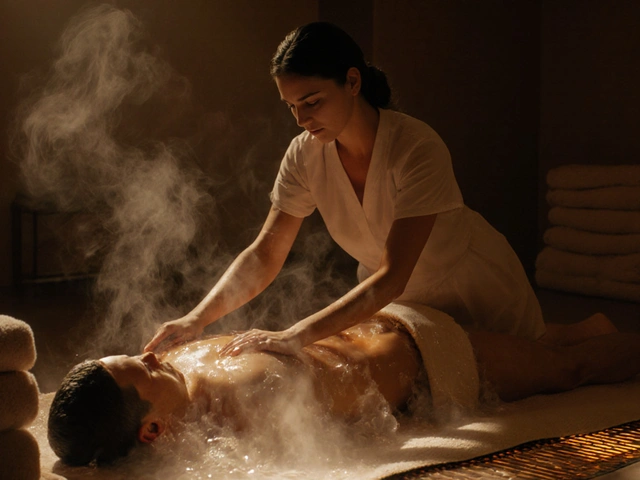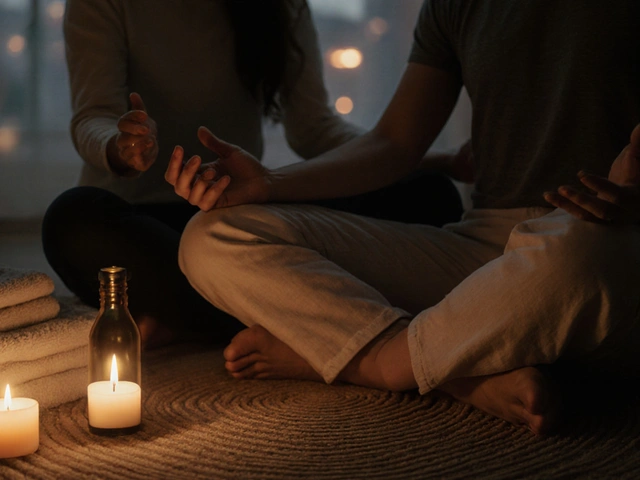You’ve probably heard whispers about tantra massage-soft music, candlelight, hands moving slowly over skin. But what if it’s not about sex? What if it’s about something deeper: connection, presence, and a kind of love that doesn’t need words?
What Tantra Massage Really Is (And What It Isn’t)
Tantra massage isn’t erotic massage. It’s not about orgasm. It’s not even really about pleasure in the way most people think of it. At its core, tantra massage is a practice of mindful touch-where every stroke, breath, and pause becomes a doorway to intimacy.
Originating from ancient Indian spiritual traditions, tantra teaches that energy flows through the body, and when that energy is awakened with awareness, it can transform how two people relate to each other. In a tantric massage for couples, the goal isn’t to get off-it’s to get present.
Think of it like this: most massages focus on relaxing muscles. Tantra massage focuses on relaxing the mind. The body becomes the language. The hands become the voice. And silence? That’s the conversation.
Why Couples Try Tantra Massage
Most couples come to tantra massage because they’ve lost the quiet moments. The kids are grown, the bills are paid, but the way you look at each other? It’s changed. You talk about schedules, not feelings. You touch out of habit, not longing.
One couple I met here in Istanbul-both in their late 40s-told me they hadn’t held each other without checking their phones in over two years. After their first session, they sat in silence for 20 minutes, just breathing together. No words. No agenda. Just presence.
Studies from the Center for Mindful Relationships show that couples who practice mindful touch for just 15 minutes a day report a 40% increase in emotional intimacy within six weeks. Tantra massage isn’t a quick fix. It’s a reset button for closeness.
Core Techniques Used in Couples Tantra Massage
There are no magic moves. No secret hand gestures. But there are a few foundational techniques that make all the difference.
- Slow, intentional touch-not rushed, not goal-oriented. A hand gliding across the back takes 30 seconds, not three. You feel every curve, every shift in muscle.
- Eye contact-not staring, not flirting. Just holding gaze while breathing together. It’s uncomfortable at first. That’s the point.
- Breath synchronization-matching your inhales and exhales with your partner’s. It’s simple, but it rewires your nervous systems to feel safe together.
- Energy mapping-instead of massaging just the back or legs, you follow the body’s energy pathways. The lower spine, the sacrum, the inner thighs-these aren’t just areas to rub. They’re gateways to emotional release.
- Non-demand presence-no expectations. No pressure to feel anything. No need to respond. You’re simply there, holding space.
One of the most powerful moments? When one partner begins to cry-not from sadness, but from being truly seen. That’s tantra.

What Happens During a Typical Session
A session usually lasts 90 to 120 minutes. You and your partner lie on separate mats, fully clothed at first. The room is warm, dim, with the scent of sandalwood or frankincense. Soft drums or Tibetan bowls hum in the background.
The therapist begins by guiding both of you through breathwork. Then, you take turns giving and receiving. One person lies still while the other is gently massaged. No nudity. No sexual contact. Just skin-to-skin touch, using warm oil and slow, circular motions.
After 45 minutes, you switch roles. The therapist might ask you to place your hand on your partner’s heart while they breathe. Or to trace the outline of their spine with your fingertips-just watching their reaction, not trying to fix anything.
At the end, you sit together, eyes closed, hands resting on each other’s knees. No talking. Just being. That’s when the magic happens-not in the massage, but in the quiet after.
How to Find Authentic Tantra Massage in Istanbul
Not every place that says "tantric" is actually tantric. Some use the word as a cover for erotic services. Here’s how to tell the difference:
- Look for practitioners who are certified through recognized lineages like the White Tantra Institute or Tantric Healing Academy.
- Check if they offer pre-session consultations. Authentic practitioners will ask about your relationship goals, boundaries, and intentions.
- Avoid places that advertise "happy endings" or "quick sessions." Tantra is slow. It’s not a service you rush through.
- Read reviews that mention emotional release, tears, or deep silence-not just "it felt good."
In Istanbul, look for studios in Beyoğlu or Kadıköy. The most trusted ones are often hidden behind unmarked doors, with no signs, just a small candle in the window. They don’t need to advertise. Their clients return.
Tantra Massage vs. Sensual Massage: What’s the Difference?
| Aspect | Tantra Massage | Sensual Massage |
|---|---|---|
| Primary Goal | Emotional connection, energy flow, presence | Physical pleasure, arousal, relaxation |
| Touch Style | Slow, deliberate, non-sexual | Flowing, rhythmic, often erotic |
| nudity | None-clothing remains on | Often involved |
| Eye Contact | Encouraged, intentional | Rarely used |
| After-Session Feeling | Deep calm, emotional clarity, bonded | Physically relaxed, possibly disconnected |
| Duration | 90-120 minutes | 30-60 minutes |
If you want to feel closer to your partner, tantra wins. If you want to feel turned on, sensual massage does that better. But only one helps you remember why you fell in love in the first place.

Safety and Boundaries: What You Need to Know
Tantra is safe-but only if you set clear boundaries. Here’s how:
- Always have a pre-session talk. Ask: "What’s off-limits?" "What does consent look like here?"
- You can stop at any time. No questions asked. No guilt.
- Don’t feel pressured to open up emotionally. It’s okay to stay quiet.
- Make sure the practitioner has training in trauma-informed touch. Many people carry deep emotional wounds. Tantra shouldn’t reopen them without support.
- If you’re uncomfortable with eye contact or silence, say so. A good practitioner will adjust.
There’s no such thing as "doing it wrong." Tantra isn’t about performance. It’s about showing up-exactly as you are.
What to Expect After Your First Session
Some people feel euphoric. Others feel raw. Some cry. Some laugh. Some just sit and stare out the window.
One man told me he didn’t cry during the massage-but that night, he held his wife’s hand for the first time in five years. He didn’t say why. He didn’t need to.
It’s common to feel emotionally vulnerable for a day or two afterward. That’s normal. Your nervous system has been recalibrated. Give yourself space. Drink water. Don’t rush back into chaos.
And if you and your partner feel closer? That’s the real sign it worked.
How Often Should Couples Do This?
There’s no rule. Some do it once a year as a ritual. Others come monthly, like a spiritual check-up.
Try this: do one session. Then, at home, spend 10 minutes a week just touching each other-no sex, no talking. Just hands on shoulders, feet on laps, foreheads together. That’s tantra in daily life.
You don’t need a therapist to practice presence. You just need willingness.
Is tantra massage only for couples in romantic relationships?
No. While most sessions are for romantic couples, some practitioners offer sessions for close friends, family members, or even parent-child pairs who want to rebuild trust. The focus is always on mindful touch, not sexual energy. Boundaries are strictly honored.
Do I need to be spiritual or religious to benefit from tantra massage?
Not at all. Many people come with zero interest in spirituality. They just want to feel less alone with their partner. Tantra works whether you believe in chakras or not. It’s about touch, breath, and attention-things everyone already knows how to do.
Can tantra massage fix a broken relationship?
It won’t fix deep betrayal or abuse. But it can create a space where healing becomes possible. Many couples use it as a bridge after therapy-relearning how to be close without fear. It’s not a cure, but it can be the first step back toward each other.
Is tantra massage legal in Turkey?
Yes, as long as no sexual activity occurs and no nudity is involved. Turkey allows therapeutic touch practices under wellness regulations. Reputable studios operate legally and avoid any language that implies erotic services. Always confirm the practitioner’s credentials and boundaries before booking.
How much does a tantra massage session cost in Istanbul?
Prices range from 800 to 1,500 Turkish Lira per session (about $25-$50 USD), depending on the practitioner’s experience and location. Higher-end studios in Beyoğlu may charge more, but you’re paying for time, training, and a safe space-not luxury. Avoid places that charge over 2,000 Lira-they’re often misleading.
Ready to reconnect? Not with your phone. Not with your to-do list. But with the person you promised to love-not perfectly, but deeply. Find a quiet room. Light a candle. Put your hand on their back. Breathe together. That’s all it takes to begin.





